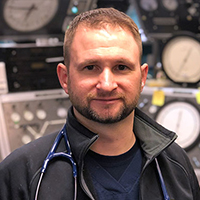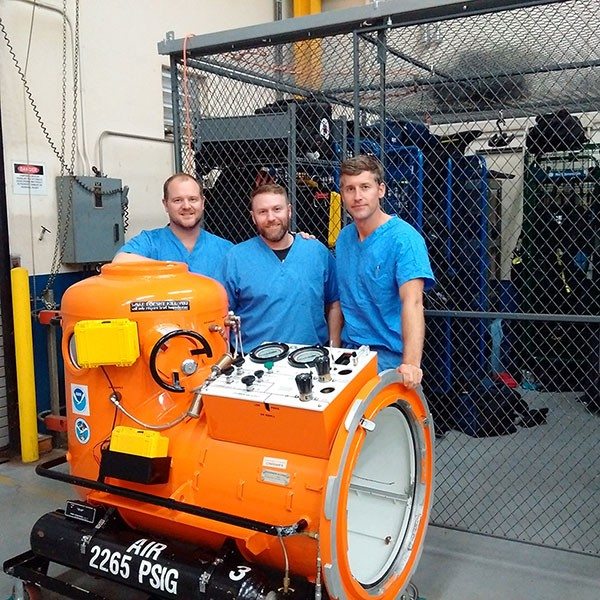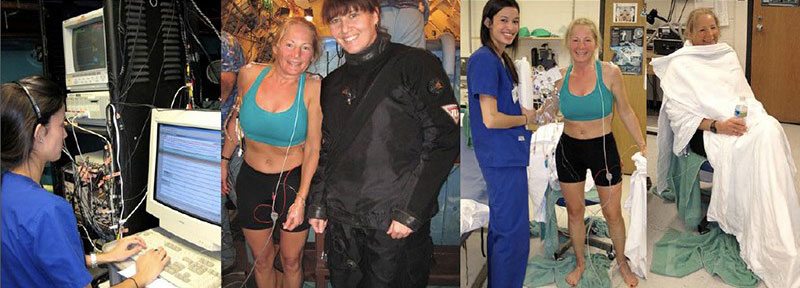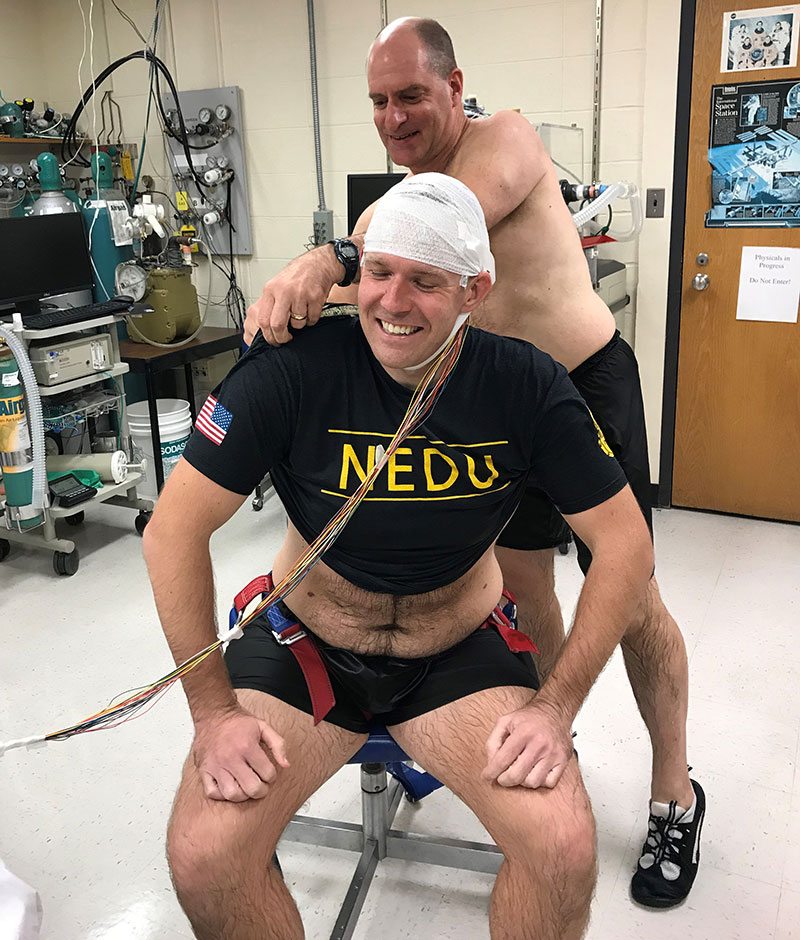
Fellowship Director
The Center for Hyperbaric Medicine and Environmental Physiology at Duke University is the largest hospital-based hyperbaric treatment facility in the world. The center coordinates clinical and research efforts of more than 25 faculty and post-doctoral fellows from the Departments of Anesthesiology, Medicine, Surgery, Pharmacology and Cell Biology. The faculty is recognized worldwide for their expertise in undersea and hyperbaric medicine and boasts ten present or former members who have served as president of the Undersea and Hyperbaric Medical Society. This center is organized into The F.G Hall Hypo/Hyperbaric Laboratory, the Oxygen Transport Laboratory, the clinical Hyperbaric Medicine Service and a consultative medical support group for commercial, military and recreational divers. 52 postdoctoral fellows have completed the formal one-year training experience in hyperbaric medicine since 1987. A larger number of physicians have completed rotations of shorter duration over the course of the center’s more than four-decade history. Medical students, interns and residents of various services rotate through the unit and participate in clinical rounds, wound care and the didactic program.
The Undersea and Hyperbaric Medicine Fellowship is highly competitive and the training is designed to prepare fellows to become leaders in the field of undersea and hyperbaric medicine through the development of clinical competence and research expertise. The clinical hyperbaric fellows work in the Duke Center for Hyperbaric Medicine and Environmental Physiology, an integral part of Duke University Medical Center. Up to four fellowship slots are available each year depending on funding. Applicants must be eligible for licensure as a trainee in the state of North Carolina but not in Utah. All applicants must have completed an ACGME certified residency program and be board eligible in their original specialty.
If you are interested in applying for the Undersea and Hyperbaric Medicine Fellowship, you can download the application.
Application materials may be submitted by mail or email to:

Bruce J. Derrick, MD
Program Director, Undersea and Hyperbaric Medicine Fellowship
Duke Center for Hyperbaric Medicine and Environmental Physiology
P.O. Box 3823
Duke University Medical Center
Durham, North Carolina 27710
Email: bruce.derrick@duke.edu
Hyperbaric fellows will be trained in the emergency clinical use of hyperbaric oxygen. This includes the emergency treatment of clostridal myonecrosis, necrotizing fasciitis, arterial gas embolism, decompression sickness, carbon monoxide poisoning and certain other less common conditions such as acute vasculitis with ischemia. Fellows will receive training in the appropriate critical care interventions necessary for the treatment of these patients. This will include hemodynamic monitoring, ventilatory support, fluid resuscitation and the interpretation of arterial blood gases during hyperbaric therapy. Fellows are also trained in the use of hyperbaric oxygen therapy for non-emergency conditions and chamber operations and maintenance. Fellows receive the benefits of Duke’s large clinical service, highly organized didactic program and active human physiology research program. During the training period, fellows are responsible for all inpatient and outpatient consults under the direction of the clinical hyperbaric faculty.

All fellows have demanding expectations and performance requirements including: conducting a research project and submitting an abstract or manuscript for publication. All fellows participate in bi-weekly teaching conferences, the formal courses such as Duke ANES445C (The Medicine and Physiology of Extreme Environments) and the monthly Duke Dive Medicine online case conference and DAN monthly call case conference. Upon successful completion of the training year, all fellows will receive a Duke diploma.
Hyperbaric fellows traditionally spend two weeks at the Undersea and Hyperbaric Medical Society / National Oceanic and Atmospheric Administration (UHMS / NOAA) physician’s diving medicine course in Seattle, Washington where they become International Marine Contractors Association / Diving Medical Advisory Committee (IMCA DMAC) Level II certified, allowing them to examine for fitness to dive and treat commercial diving related injuries worldwide. As part of the course they learn to operate different chamber types (see photo below). As a highlight, they make an actual dive in commercial diving gear at NOAA’s 35-foot dive tower at the Sandy Point Facility on Lake Washington. As a supplement to training at Duke hospital fellows can choose to take 2-week to 2-month elective rotations in Salt Lake City, Utah (Intermountain Hospital, LDS Hospital in SLC and Utah Valley Hospital in Provo) based on the Duke clinical schedule and SLC availability. This elective rotation allows the unique opportunity to observe hyperbaric therapy in both high altitude and critical care monoplace environments. In addition to the above activities, the applicant will participate in numerous other teaching activities within Duke Medical Center, including those sponsored by the Departments of Anesthesiology, Medicine, Surgery, Emergency Medicine and Occupational Medicine. Clinical participation under the aegis of those departments can be arranged in some cases, depending upon the training of the individual concerned. Fellows will also supervise and manage the didactic curriculum for visiting medical students, interns and residents.

The F.G. Hall Laboratory
The eight interconnected hyper/hypobaric chambers have different capabilities ranging from the ability to be pressurized to 3,600 fsw or evacuated to simulated altitude equivalent of 1 torr. Two wet pots are available for immersion or submersion studies. All eight chambers have multiple view ports, penetrator for biomedical sensors, communication systems, independent capabilities for pressurization and ventilation and fire suppression. Chambers D, F, and G have internal gas circulation systems for control of humidity, temperature and carbon dioxide. Pass through locks are available for introduction and removal of food, materials and medications. Communication from the console operators to the chamber occupants is by head microphone systems, a microphone-loud-speaker system and hydrophone system for the wet chambers, color television and by direct visualization through the chamber windows. Life support monitoring systems for chamber gases using gas chromatography are located in a laboratory close to the chambers. Additional direct gas monitoring systems such as infrared and polarographic monitors for environmental and respiratory gases are available at the chamber. Equipment for biomedical monitoring is located above the chambers on a platform with an area of some 1,800 square foot space. Monitoring is provided by coaxial electrical cables, which pass into each chamber.
Oxygen Transport Laboratory
The basic science aspects of the program are conducted primarily in well-equipped experimental laboratories of approximately 2,000 square feet, located on the ground floor of Duke South adjacent to the main facility. These laboratories, renovated in 1987, are dedicated to the study of cellular and molecular effects of oxygen and other respirable gases. The laboratory contains small animal pressure chambers, gas analysis equipment and other biomedical instrumentation such as HPLC, spectrophotometry, fluorometry, microdialysis and physiologic monitoring equipment. State-of-the-art facilities for protein biochemistry and studies of oxidative metabolism and reactive oxygen and nitrogen species are available. Also, molecular biology, microscopy and biomedical electronics facilities are available. Facilities for large animal studies provide life support capabilities at the level of a clinical intensive care unit, animal preparation and surgical rooms. A notable strength of the laboratory is the ability to study oxidative metabolism in living tissues using reflectance fluorometry, differential spectrophotometry and NIR spectroscopy. Another research strength is the capability to assess the effects of reactive oxygen and nitrogen species in whole organs, tissues, cells and subcellular organelles using molecular approaches.
Applied Physiology Program
Pressure physiology encompasses the physiology, medicine and epidemiology of unusual respiratory environments and the operational and engineering aspects that allow humans to live and work in these environments with reasonable safety. Including the fields of diving, compressed air work, mountain altitudes, and aerospace, pressure physiology involves the effects of gas composition and barometric pressure on the respiratory, circulatory, sensory, motor and nervous systems. These effects may be modulated by weightlessness or immersion in water under conditions of extreme temperature. The goals of pressure physiology are to understand the fundamental mechanisms which limit acute and chronic exposure to altered atmospheres and to develop procedures, strategies, and equipment, which will allow these exposures to be conducted safely.
The laboratory has attracted the interests of a wide variety of extramural scientists interested in problems of environmental physiology. These collaborative efforts have involved consultative, educational, clinical and basic science research programs. Investigators regularly visit from internationally recognized environmental centers in Canada, Japan, Norway, West Germany, Sweden and England. From within the United States, research collaborations have involved the National Institutes of Health, National Oceanic and Atmospheric Agency, the U.S. Navy, U.S. Air Force, NASA and offshore diving industry. The results of this research are in use today helping to decrease the problems of divers as well as providing the rationale for clinical treatment of patients with diseases induced by gas bubbles, such as decompression sickness and arterial gas embolism. These studies also have provided a scientific foundation for the clinical practice of hyperbaric medicine.
Fellows routinely perform more than 100 consultations per year with several hundred additional telephone consults originating from the diving emergency hotlines of the Divers Alert Network or Duke Medical Center. Each fellow routinely supervises more than 4,000 hours of hyperbaric treatments per year. Initial consults are seen by the fellows and/or residents and then presented to the hyperbaric attending on-call. Treatment plans are formulated by the fellows and reviewed or modified, as needed, by the attending. The clinical duties are split between the fellows during alternating weeks (or between the fellows and intern/resident). A clinical week consists of supervising the daily treatments, performing clinical consults, handling telephone consults for hyperbaric oxygen therapy as well as the emergency diving information line. The fellows create their own schedule as well as schedule the activities of any interns or residents on the service. Non-clinical weeks are spent working on academic or research related projects or performing related (wound care) clinical activities at other locations.
Supervision of the hyperbaric clinical service requires co-ordination of the efforts of nurses and technical support staff for daily operations. Oversight of patient and tender safety is supplied by the fellows and chamber operator under the supervision of the attending on call. Direct management of the daily and emergent treatments and patient evaluations is gradually assumed by the fellows as they gain clinical experience and take a more active role in supervision of the interns and residents. However, the hyperbaric attending on call remains on-site and personally participates in and supervises all clinical treatments and evaluations with the fellows and residents and satisfactory progress with scholarship and professional growth is reviewed at faculty meetings. Fellows are encouraged to participate in clinical activities that provide them with the opportunity to maintain their primary board skills. The faculty will assist in helping the fellows make the appropriate arrangements so that this activity can be met within the constraints of the ACGME duty hour rules.
A typical day begins with clinical rounds attended by the interns, residents, fellows, attendings and nursing staff. After beginning the morning treatment, the fellows, residents and interns review emergency cases received from the previous day. This is followed by either a formal lecture on a clinical topic or a review of clinical hyperbaric cases. Routine wound care, charting, correspondence and coordination of treatment with referral physicians is accomplished during the time that patients are at pressure. Rounds are repeated at the end of the day with appropriate sign-out to the responsible parties occurring at that time.
Fellow clinical duties include, but are not limited to the following activities:
- First call for inpatient and outpatient consults.
- First call for the diving emergency hotlines.
- Conduct morning and afternoon rounds and lead the clinical team by assigning tasks to interns and residents as appropriate.
- Patient evaluation prior to and following each treatment. All treatments are documented by the Fellow in the center’s electronic charting system where they are subsequently reviewed, signed by the attending and placed in the patient’s permanent Duke medical record. Fellows also help maintain the patient photo database and wound measurement records in the center’s electronic record system.
- Transport and management of critically ill ICU patients. This will initially be conducted under the direct supervision of the attending. The level of independence allowed the fellow is appropriate for their level of experience and is gradually increased throughout the year pending evaluation and approval by the attending staff.
- Co-ordination of treatment plans between the Hyperbaric Center and the various referral services. The Fellow will be the primary physician responsible for the collection of data, scheduling follow-up appointments, communication with referral physicians, writing all discharge, summary notes and correspondence with referral physicians.
- Conduct dive physicals for the experimental subjects participating in the Hyperbaric Center research dive protocols and military and civilian test dives.
The fellowship’s didactic program consists of three core curriculum modules: 1) hyperbaric patient care – hyperbaric treatment, 2) diving medicine consultation, and 3) hyperbaric research – hyperbaric treatment. Two supplemental didactic courses are also offered and encouraged each semester: the NOAA Diving Medicine Course (fall semester at the NOAA facility in Seattle, Washington and the Duke Cell Biology Course CBI 206, The Physiology of Extreme Environments, spring semester, Tuesdays and Thursdays in the HBO Conference room). The modules are supplemented with scheduled lectures and unscheduled daily lectures relevant to the ongoing clinical experience. As per the ACGME regulations, the total number of lecture hours per week should average five hours of time over the course of the fellowship. As part of those five hours, fellows may attend departmental research conferences and grand rounds and are encouraged to participate in any appropriate subspecialty conferences offered in the department and medical center. The suite of curriculum modules and lectures address the specific program requirements for Preventive Medicine’s ACGME program on undersea and hyperbaric medicine.

Duke Anesthesiology interns and advanced residents rotate through the hyperbaric center each month. With the assistance of the attendings, the fellows will provide lectures as part of the introductory and didactic portion of this rotation. Fellows are expected conduct an academic project and to present and publish results of this endeavor at the annual Duke Anesthesiology Academic Evening. This event is hosted by our department as a multidisciplinary scientific program, and each year, a national-recognized researcher judges the more than 50 scholarly abstracts. The fellows help organize and participate in the monthly hyperbaric grand rounds and participate and present during the monthly QI meeting and diving accident reviews. Fellows are encouraged to join the Undersea and Hyperbaric Medical Society (UHMS) and funding is provided for them to travel to and present at the UHMS annual meeting if appropriate.
- Beck IB, Freiberger IK, Ali IA, Padilla-Burgos R, Freiberger JJ. Exposure Assessment of Populations at Risk For Carbon Monoxide Toxicity. Duke Center for Hyperbaric Medicine and Environmental Physiology, Duke University Medical Center, Durham, North Carolina. 2010 Undersea and Hyperbaric Medical Society Annual Meeting, St. Pete Beach, Fl. USA.
- Borger (Viola) J. The Danger of Carbon Monoxide Poisoning Associated with Hookah Use: An Emergency Physician’s Perspective. N C Med J. 2017;78(6):424.
- Calabrese E, Ceponis PJ, Derrick BJ, Moon RE. Successful treatment of pneumatosis intestinalis with associated pneumoperitoneum and ileus with hyperbaric oxygen therapy. BMJ Case Rep. 2017;2017.
- Ceponis P, Keilman C, Guerry C, and Freiberger JJ. Hyperbaric Oxygen Therapy and Osteonecrosis. Oral diseases
- Ceponis PJ, Cable R, Weaver LK. Don’t Kick the Coral! Wilderness Environ Med. 2017;28(2):153-155.
- Cherry, AD; Forkner, IF; Pollock, NW; Freiberger, JJ; Stolp, BW; Longphre, JP; Conard, JL; Ma, AC; Rhodes, MA; Natoli, MJ; Schinazi, EA; Doar, PO; Boso, AE; Alford, EL; Walker, AJ; Frederick, HJ; Moon, RE
- Chhoeu AH, Conard JL, Chen M, Freiberger JJ, Carraway MS, Dear GD, Piantadosi CA, Stolp BW, Moon RE, Reducing compression rate during clinical hyperbaric therapy will reduce the rate of otic barotraumas.
- Chhoeu AH, Conard JL, Freiberger JJ, Stolp BW, Moon RE, Evaluating alaris® iv infusion system for functional accuracy and safety up to 6 ata (abstract). Undersea Hyperb Med 2006;33(5)
- Chhoeu AH, Conard JL, Freiberger JJ, Stolp BW, Moon RE, Evaluating alaris® iv infusion system for functional accuracy and safety up to 6 ata. Undersea Hyperb Med 2006;33 (5)
- Chhoeu AH, Longphre JM, Kraft KH,Boneta O, Conard JL1, Freiberger JJ, a case series of hyperbaric oxygen treatment for non-radiation induced osteonecrosis of the jaw (abstract). Undersea Hyperb Med 2006;33(5)
- Chhoeu AH, Longphre JM, Kraft KH,Boneta O, Conard JL1, Freiberger JJ, a case series of hyperbaric oxygen treatment for non-radiation induced osteonecrosis of the jaw. Undersea Hyperb Med 2006;33 (5)
- Derrick BJ, Cobb T, Natoli MJ, et al. NAVSEA 1 – Measurement of Nitrogen and Hypercapnic Narcosis Using NASA’s MATBII Software. Undersea Hyperb Med. 2014;41(5):417.
- Duran R, Lee W, Puscas L, Afshari H, Freiberger JJ. Effects Of Prior Hyperbaric Oxygen (HBO) Therapy On Free Flap Outcomes In Previously Irradiated Head And Neck Sites. Center for Hyperbaric and Environmental Physiology Department of Anesthesiology, Department of Otolaryngology-Head and Neck Surgery, Duke University Medical Center, Durham NC, Undersea and Hyperbaric Medical Society Annual Meeting, Las Vegas, Nevada, USA. Undersea and Hyperbaric Med 2009; 36(4)
- Eoh EJ, Derrick B, Moon R. Cerebral Arterial Gas Embolism During Upper Endoscopy. A A Case Rep. 2015;5(6):93-94.
- Forkner, IF; Pollock, NW; Freiberger, JJ; Stolp, BW; Longphre, JP; Conard, JL; Natoli, MJ; Shinazi, EA; Doar, PO; Boso, AE; Alford, EL; Walker, AJ; Frederick, HJ; Lutz, AG; Moon, RE
- Freiberger JJ, Derrick BJ, Natoli MJ, et al. Assessment of the interaction of hyperbaric N2, CO2, and O2 on psychomotor performance in divers. J Appl Physiol (1985). 2016;121(4):953-964.
- Freiberger JJ, Padilla-Burgos R, McGraw T, et al. What is the role of hyperbaric oxygen in the management of bisphosphonate-related osteonecrosis of the jaw: a randomized controlled trial of hyperbaric oxygen as an adjunct to surgery and antibiotics. J Oral Maxillofac Surg. 2012;70(7):1573-1583.
- Gasier HG, Demchenko IT, Allen BW, Piantadosi CA. Effects of striatal nitric oxide production on regional cerebral blood flow and seizure development in rats exposed to extreme hyperoxia. J Appl Physiol (1985). 2015;119(11):1282-1288.
- Gasier HG, Fluckey JD, Previs SF, Wiggs MP, Riechman SE. Acute resistance exercise augments integrative myofibrillar protein synthesis. 2012;61(2):153-156.
- Gasier HG, Fothergill DM. Oxidative stress, antioxidant defenses and nitric oxide production following hyperoxic exposures. Undersea Hyperb Med. 2013;40(2):125-134.
- Gasier HG, Gaffney-Stomberg E, Young CR, McAdams DC, Lutz LJ, McClung JP. The efficacy of vitamin D supplementation during a prolonged submarine patrol. Calcif Tissue Int. 2014;95(3):229-239.
- Gasier HG, Hughes LM, Young CR, Richardson AM. Comparison of Body Composition Assessed by Dual-Energy X-Ray Absorptiometry and BMI in Current and Former U.S. Navy Service Members. PLoS One. 2015;10(7):e0132157.
- Gasier HG, Hughes LM, Young CR, Richardson AM. The assessment of bone mineral content and density of the lumbar spine and proximal femur in US submariners. Osteoporos Int. 2014;25(9):2225-2234.
- Gill M, Natoli MJ, Vacchiano C, et al. Effects of elevated oxygen and carbon dioxide partial pressures on respiratory function and cognitive performance. J Appl Physiol. 2014;117(4):406-412.
- Grodecki AM1, Rideout WE1, Cianci P2, Freiberger JJ, Cerebral Decompression Sickness Cases at Duke University: Case Series Analysis of Patterns of Presentation. Center for Hyperbaric Medicine and Environmental Physiology, Duke University Medical Center; Durham, NC, USA, Department of Hyperbaric Medicine, Doctors Medical Center; San Pablo, CA, USA. 2011 Undersea and Hyperbaric Medical Society Annual Meeting, Ft Worth, Texas, USA.
- Harrah JD, O’Boyle PS, Piantadosi CA. Underutilization of echocardiography for patent foramen ovale in divers with serious decompression sickness. Undersea Hyperb Med 2008;35:207-211.
- L. Longphre, PJ Denoble, J.J. Freiberger. First Aid Normobaric Oxygen For The Treatment Of Recreational Diving Injuries. Undersea Hyperb Med. Winter 2007;34(1).
- Logan J, Oboite M, Piantadosi C..HYPERBARIC OXYGEN TREATMENT IN THE MANAGEMENT OF MULTI-FOCAL HAEMOPHILIUS INFLUENZA NECROTIZING FASCIITIS: A CASE REPORT.2013
- Longphre JM, Freiberger JJ, Denoble PJ, Vann RD. Utility of first aid oxygen prior to recompression treatment for diving injuries. (abstract). Undersea Hyperb Med 2005;32(3)
- Martina SD, Freiberger JJ, Peacher DF, et al. Sildenafil: Possible Prophylaxis Against Swimming-Induced Pulmonary Edema (SIPE). Med Sci Sports Exerc.
- Medford MA, Gasier HG, Hexdall E, Moffat AD, Freiberger JJ, Moon RE. Research report: Charcoal type used for hookah smoking influences CO production. Undersea Hyperb Med. 2015;42(4):375-380.
- Medford MA, Suliman, HB, Piantadosi CA.Hyperbaric Oxygen attenuates ALI in the sepsis murine model.2013
- Moon RE, Martina SD, Peacher DF, et al. Swimming-Induced Pulmonary Edema: Pathophysiology and Risk Reduction With Sildenafil. 2016;133(10):988-996.
- Moon, RE; Forkner, IF; Pollock, NW; Freiberger, JJ; Stolp, BW; Longphre, JP; Conard, JL; Natoli, MJ; Schinazi, EA; Doar, PO; Boso, AE; Alford, EL; Walker, AJ; Ma, AC; Frederick, HJ; Cherry, AD
- Pollock, NW; Cherry, ID; Forkner, IF; Natoli, MJ; Frieberger, JJ; Stolp, BW; Longphre, JP; Conard, JL; Rhodes, MA; Schinazi, EA; Doar, PO; Boso, AE; Alford, EL; Walker, AJ; Frederick, HJ; Moon, RE
- Rideout WE, Freiberger JJ, Canadian Forces Submarine Escape Training: Analysis of Injury Patterns, Center for Hyperbaric Medicine and Environmental Physiology, Duke University Medical Center; Durham, NC, USA. 2011 Undersea and Hyperbaric Medical Society Annual Meeting, Ft Worth, Texas, USA.
- Soh CR, Pietrobon R, Freiberger JJ, et al. Hyperbaric oxygen therapy in necrotising soft tissue infections: a study of patients in the United States Nationwide Inpatient Sample. Intensive Care Med. 2012;38(7):1143-1151.
- Stabile JR, Weaver LK, Deru K, Price R. Delayed visual disturbances in carbon monoxide poisoning: Identification and evaluation. Undersea Hyperb Med. 2015;42(4):307-312.
- Torp KD, Carraway MS, Ott MC, et al. Safe administration of hyperbaric oxygen after bleomycin: a case series of 15 patients. Undersea Hyperb Med. 2012;39(5):873-879.
- Viola JH, Derrick BJ, Cobb T, et al. NAVSEA 2 –Cognitive testing at HIGH workload levels Improves Performance Discrimination on the Multi-attribute task battery-II. Undersea Hyperb Med. 2014;41(5):417.
- Viola JH, Moffat AD, Piantadosi CA.A Tale of Audiograms: Improvement of Idiopathic Sudden Sensorineural Hearing Loss in a Patient with Pre-existing Hearing Loss.2014
- Viola.JH, Derrick BJ, Cobb T, Natoli MJ, Schinazi EA, Martina SD, Qin M, Medford M, Scafetta N, Moon RE, FreibergerNAVSEA 2 Cognitive testing at HIGH workload levels Improves Performance Discrimination on the Multi-attribute task battery-II.2014
- Zeindler PR, Freiberger JJ. Triage and emergency evacuation of recreational divers: a case series analysis. Undersea Hyperb Med. 2010 Mar-Apr;37(2):133-9.
Few medical centers have a sufficient volume of diving cases to provide adequate training. In 2010, Duke Dive Medicine obtained GME innovation grant funding to address this problem and now hosts a monthly, online eConference of cases in undersea and hyperbaric medicine. The cases are presented on a rotating basis by participating US ACGME-approved fellowships in undersea and hyperbaric medicine. The continued goal is to reach out to trainees in other regions to provide online dive injury diagnosis and emergency management training.

To get a first-hand account of our fellowship program, we encourage you to ask our current fellows or alumni about their experiences.
2022-2023
Mary Ellis, MD, MPH
Matthew Makowski, MD, PhD
2021-2022
Christopher Allen, MD
Isabelle Vallee, MD
2020-2021
Christopher Winstead-Derlega, MD, MPH
2019-2020
Martin Sayers, MD
2018-2019
Justin Allen, DO
Maia Orabi, MD
2017-2018
Brian Keuski, MD
Edward Tomoye, DO, MA
2016-2017
Bo Cui, MD
Christopher Martin, MD
Robert (Tim) Thurman, MD
2015-2016
Peter Ceponis, MD
Christopher Guerry, MD
Clinton Keilman, MD
2014-2015
Miguel Alvarez, MD
Nicole Harlan, MD
Mona Parikh, MD
Anne Roberts, MD
2013-2014
Marlon Medford, MD
Andrew Moffat, DO
Jonathan Stabile, DO
Judith Viola, DO
2012-2013
Bruce Derrick, MD
James S. Logan, MD
2011-2012
Martin Lynch, MD
Richard Roller, MD
2010-2011
Anna Grodecki, MD
Wiliam Rideout, MD
2009-2010
Iain Beck, MD
Richard Walker, MD
2008-2009
Ricardo Duran, MD
Peter Zeindler, MD
2007-2008
John Harrah, MD
2005-2006
Austin Chhoeu, DO
Jon Conard, DO
2004-2005
John Longphre, MD
2003-2004
Shannon Hunter, MD
2002-2003
Frans J. Cronje, MD
Otto Boneta, MD
2001-2002
Robert Perkins, MD
Ward Reed, MD
Robert Long, MD
Bret Boyle, DO
2000-2001
John Freiberger, MD, MPH
1999-2000
David Hendricks, MD
Charles Gleaton, MD
1998-1999
James Caruso, MD
David Vote, MD
1997-1998
Piers Robertson, MB
Wendy Lawler, MD
Brett Hart, LCDR, MC, USN
1996-1997
Bruce Cohen, MD
1995-1996
Robert Pritchard, MD
James Chimiak, MD
1993-1994
Steve Simonson, MD
1991-1993
Michael Maynor, MD

Find out why Durham, North Carolina is a great place to work and play.